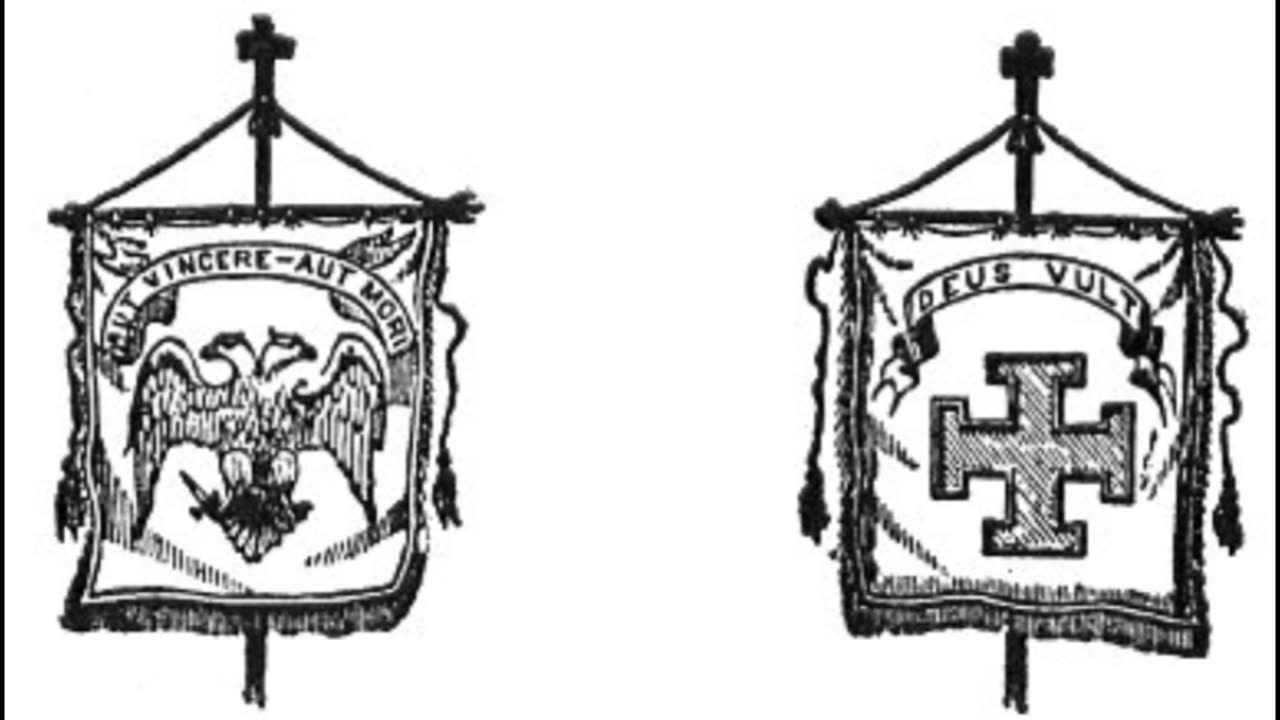Premium Only Content

Chapter 30º - Knight Kadosh - Morals & Dogma of the Ancient & Accepted Scottish Rite of Freemasonry
This chapter is dedicated to the Knight Kadosh or the 30th degree of the Scottish Rite of Freemasonry, delves into one of the most philosophical and symbolically rich degrees within the Masonic hierarchy. This degree, also known as the Knight of the White and Black Eagle, explores themes of judgment, justice, and the perpetual fight against tyranny and oppression. Pike's exposition on the Knight Kadosh degree is a profound reflection on moral and ethical dilemmas faced by individuals seeking to uphold the highest virtues of knighthood and Masonic principles.
In this chapter, Pike interprets the allegories and symbols associated with the degree, discussing the historical and mythical narratives that shape its rituals and teachings. The Knight Kadosh is presented not just as a degree of vengeance, as commonly misconstrued, but as a call to moral warfare against the forces of injustice and ignorance that plague society. Pike emphasizes the importance of discretion, loyalty, and the pursuit of truth through the rigorous examination of one's own beliefs and actions.
This degree serves as a culmination of the philosophical journey through the degrees of the Scottish Rite, requiring deep introspection and commitment to the Masonic quest for light and truth. Pike's writings urge Masons at this level to act as champions of the oppressed and defenders of moral law, embodying the chivalric ideals that are central to the degree's symbolism.
The exploration of this chapter provides listeners with a deeper understanding of Masonic philosophy as it pertains to justice, morality, and the higher duties of a Knight Kadosh. It highlights Pike's mastery in weaving complex historical, religious, and esoteric threads into a coherent philosophical discourse that remains relevant to the ethical challenges of the modern world.
About the Book:
Morals & Dogma of the Ancient and Accepted Scottish Rite of Freemasonry was first published in 1871 and authored by Albert Pike, who was a deeply influential figure within the Scottish Rite. The book is a comprehensive collection of philosophical and instructional essays on each degree of the Scottish Rite, from the 1st to the 33rd. It is considered one of the most profound and enduring works on Freemasonry, reflecting Pike’s vast knowledge of philosophy, esotericism, and various religious traditions.
The work is structured into 32 chapters, each corresponding to one of the Masonic degrees of the Scottish Rite, with an additional introductory chapter on the 33rd degree. Pike elaborates on the symbolic, ethical, and philosophical teachings associated with each degree, making extensive use of allegorical and scriptural references to explore themes such as morality, justice, and truth.
Morals & Dogma is revered not only for its depth in explaining the symbolic meanings of Masonic rituals but also for Pike’s efforts to contextualize Masonic teachings within the broader scope of Western and Eastern philosophical thought. His interpretations draw from a myriad of sources, including Biblical scriptures, classical philosophy, medieval Kabbalah, and other mystical and religious texts, showcasing Freemasonry as a unique conduit for spiritual and moral development.
The book’s enduring relevance comes from its ability to weave complex theological, philosophical, and historical threads into a coherent system of moral conduct and metaphysical understanding. It serves as both a guide and a philosophical treatise, intended to inspire contemplation and ethical conduct among Masons.
While Morals & Dogma has historically been a key manual for those within the Scottish Rite, its appeal extends beyond Masonic circles due to its rich discussions of morality and spirituality. It remains a significant work for anyone interested in the philosophical underpinnings of fraternal orders or in the broader dialogue between ancient wisdom traditions and modern ethical challenges.
About the Author:
Albert Pike (1809–1891) was a multifaceted American figure known for his roles as a lawyer, writer, soldier, and influential Freemason. Born in Boston, Massachusetts, Pike moved to the frontier, which today is Arkansas, where he practiced law, worked as a journalist, and engaged in various political activities.
Pike's Masonic journey is as storied and complex as his public life. He was deeply involved in the development of the Scottish Rite of Freemasonry and became the Sovereign Grand Commander of the Southern Jurisdiction of the Scottish Rite from 1859 until his death in 1891. Under his leadership, the Scottish Rite flourished, and Pike authored Morals and Dogma of the Ancient and Accepted Scottish Rite of Freemasonry in 1871, a book that remains a cornerstone of Masonic literature.
Beyond the Scottish Rite, Pike was active in many other Masonic bodies. He was a founding officer of the Knights of the Golden Circle and was involved in the development of several York Rite bodies. His Masonic work extended internationally; he played a crucial role in promoting and organizing Freemasonry in Europe and Latin America.
During the American Civil War, Pike served as a brigadier general in the Confederate States Army, commanding the District of Indian Territory. His service in this capacity was marked by controversies, including disagreements with superior officers and the government's policies toward Native American tribes. Despite his military and political engagements, his contributions to Masonic scholarship and ritual remain his most enduring legacy.
Pike's interests and writings spanned a wide range of subjects, including philosophy, astrology, and comparative religion, which influenced his Masonic writings and teachings. His intellectual pursuits reflected his belief in the universality of all religions and the synthesis of philosophical truths across different cultures.
Albert Pike's life was characterized by his vigorous intellect, his dedication to the ideals of Freemasonry, and his controversial role in the historical events of his time. His Masonic work, especially through Morals and Dogma, continues to be studied and revered in Masonic circles worldwide, cementing his place as one of the most significant figures in the history of Freemasonry.
-
 4:52
4:52
Deus Meum Que Jus
19 days agoAlex Jones I Don't Even Blame Israel for the Attack on the USS Liberty
585 -
 LIVE
LIVE
sophiesnazz
1 hour agoLETS TALK ABOUT BO7 !socials !specs
30 watching -
 LIVE
LIVE
MadHouseRetro
1 hour agoPUFFCO PIVIOT BUNDLE GIVEAWAY! and Spider-man 2 playthough!
75 watching -
 1:12:40
1:12:40
Wendy Bell Radio
11 hours agoPet Talk With The Pet Doc
54.2K30 -
 LIVE
LIVE
Biscotti-B23
43 minutes ago🔴 LIVE TOURNAMENT PRACTICE ⚔ TOP 100 RANK 👑 DEMON SLAYER HINOKAMI CHRONICLES 2
21 watching -
 LIVE
LIVE
FusedAegisTV
16 hours agoStreet Fighter 6 FINALS, CS2 Semifinals | $1,250,000 | Riyadh, Saudi Arabia EWC 2025 !estv
146 watching -
 40:42
40:42
SouthernbelleReacts
1 day ago $0.10 earned😂 American Pie (1999) Reaction | Iconic Teen Comedy, High School Chaos & 90s Nostalgia 🥧
33.5K4 -
 5:05:02
5:05:02
LumpyPotatoX2
6 hours agoBecome a HellDiver Today - #RumbleGaming
47.8K1 -
 4:52:02
4:52:02
Midnight In The Mountains
8 hours agoGaming w/ PER·SE·VER·ANCE | Sassy Saturday Fortnite | with the Midnights!
35.1K3 -
 6:22:35
6:22:35
shyboyking
6 hours agoThe Bots Of The Bots !!!😎
55.6K2